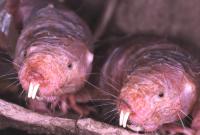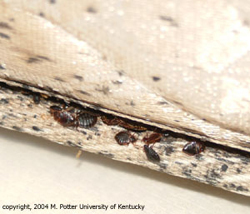Brown-banded Cockroaches
(Supella longipalpa)
 |
| Brown-banded cockroach |
Cockroaches are among
the most common of insects. Fossil evidence indicates that cockroaches have
been on earth for over 300 million years. They are considered one of the most
successful groups of animals. Cockroaches are so adaptable, they have
successfully adjusted to living with humans. About 3,500 species of cockroaches
exist worldwide, with 55 species found in the United States
Description and
Behavior
Adult male
brown-banded cockroaches are about 1/2 inch long and light brown, with fully
developed wings . The adult females are shorter and stouter than the males and
their wings do not cover the entire abdomen. Both adults and nymphs can be
distinguished by the two brownish, broad bands across the body at the base of
the abdomen and at mid-abdomen. Both males and females are quite active; adult
males fly readily when disturbed. Brown-banded cockroaches prefer warm and dry
locations, such as near refrigerator motor housings, on the upper walls of cabinets,
and inside pantries, closets, dressers, and furniture in general. They can also
be found behind picture frames and beneath tables and chairs, and inside
clocks, radios, light switch plates, doorframes, and dressers. It is common to
find them hiding nearer the ceiling than the floor and away from water sources.
Accurate identification is paramount to controlling brown-banded cockroaches.
Control strategies for other cockroaches will not be efficacious for
brown-banded cockroaches.
Life Cycle
The brown-banded
cockroach has three developmental stages: egg, nymph, and adult. Eggs are laid
in capsules, which the female carries for about 30 hours before she fastens it
on walls, ceilings, and in protected and hidden areas. During her adult life a
female produces about 14 egg capsules, each containing an average of 13 eggs.
The length of the egg stage varies from 37 to 103 days, depending on
temperature. The nymphal stage ranges from 8 to 31 weeks. A female adult has a
life span of 13 to 45 weeks; each female produces about 600 descendants per
year.
 |
| Brown-banded nymphs and adults (with egg sack) |
Damage
The brown-banded
cockroach feeds on a wide variety of materials. Like members of other cockroach
species, it may consume materials like glue or paste (especially from
animal-based materials), starch, and certain color dyes. As a result, items
like stamps, envelopes, bindings of older books, draperies, and occasionally
wallpapers may show signs of feeding. This species has also been known to chew
on nonfood materials, such as nylon stockings, presumably for the residues of
body oils and skin flakes. Damage by brown-banded cockroaches results from
their feeding and harboring in pantries and storage areas indoors. Also,
bacteria and protozoa that cause diseases (such as different forms of
gastroenteritis and diarrhea) can be carried on the legs and bodies of
cockroaches and deposited on food, utensils, etc.
Management Strategies
Survey - To control
brown-banded cockroaches, it is important to do a thorough inspection, or
survey. Cockroach surveys involve placing sticky traps (glueboards) at
strategic locations within the building. Whenever possible, place survey traps
either against a wall or in a corner of the floor, a shelf, or a drawer. Most
commercially available traps come complete with bait to encourage cockroaches
to enter. One week of trapping with a sufficient number of trap sites (ten or
more) usually provides enough information for effective control. Treatments
should be directed to those areas where cockroaches have been collected in the
traps.
 |
| Brown-banded cockroach |
Sanitation,
Structural Modifications, and Repairs
It is difficult to
keep cockroaches from entering the home via boxes, grocery bags, suitcases,
etc., but you can prevent them from developing into a serious problem. One of
the key factors is sanitation: clean up spilled foods on the floor, do not
leave dirty dishes overnight, store items such as cereal, crackers, and cookies
in airtight containers, and empty garbage each evening into a sturdy container
with a tight-fitting lid. Brown-banded cockroaches can conceal themselves in
many places that are inaccessible to larger species. Making structural
modifications such as caulking (in cracks, crevices; around ducts, molding,
etc.) is necessary in bedrooms, bathrooms, dining rooms, and other areas of the
house.
 |
| Brown-banded cockroach |
Chemical Control
Baiting is an
effective method to control or eliminate brown-banded cockroaches. Baits
containing hydramethylnon, sulfluramid, boric acid, or abamectin can provide a
high level of control when applied to those areas where cockroaches harbor. Some
formulations of baits are available to the public in plastic feeding stations.
Professional pest control personnel also have cockroach baits in flowable
granular and gel formulations. Care should be taken to closely follow the label
instructions for use. Insecticidal dusts like boric acid, silica aerogel, and
diatomaceous earth can provide additional control. Apply dusts lightly, as
heavy deposits may repel cockroaches. These products can be applied in the
cracks and crevices of bureaus, clothes closet shelves, ceiling light fixtures,
valances above windows, hollow legs of chairs and tables, and wall or floor
cracks and crevices throughout the house. Do not place dusts where they could
come in contact with children or pets. Do not allow children access to areas
treated with boric acid. Boric acid is of low toxicity to adults, but it can
present a hazard to children. Take precautions to assure that dusts do not
contaminate food. The use of residual insecticidal sprays or aerosol foggers
within a structure is of little value in controlling brown-banded cockroaches.
In fact, these applications may disperse the cockroaches making control
difficult and lengthy.
Warning
Pesticides are
poisonous. Read and follow directions and safety precautions on labels. Handle
carefully and store in original labeled containers out of the reach of
children, pets, and livestock. Dispose of empty containers right away, in a
safe manner and location. Do not contaminate forage, streams, or ponds.
Originally Authored by: Steve Jacobs, Sr. Extension
Associate
March 2002 Reviewed April 2007 © The Pennsylvania State University 2012
Edited, Revised and Condensed by: Scott Glaze
January 29, 2012
Thank you for visiting our Blog.
To find, follow and engage with us on other social media platforms, please visit:























